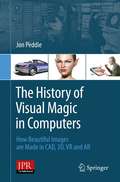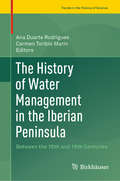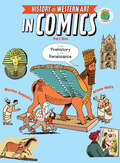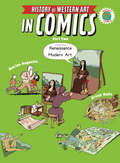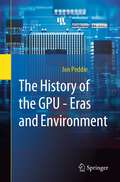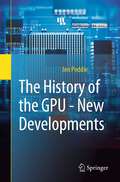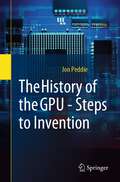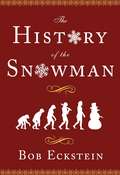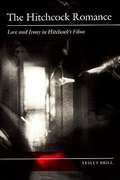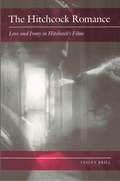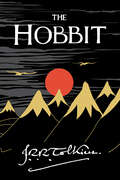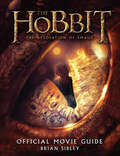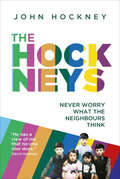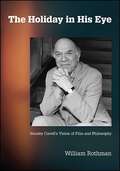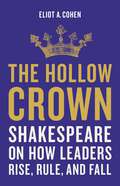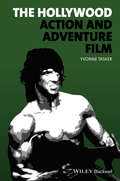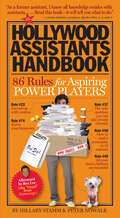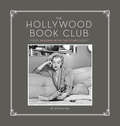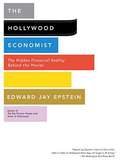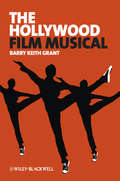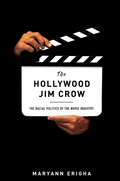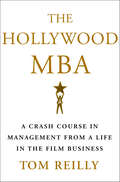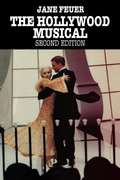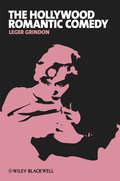- Table View
- List View
The History of Visual Magic in Computers
by Jon PeddieIf you have ever looked at a fantastic adventure or science fiction movie, or an amazingly complex and rich computer game, or a TV commercial where cars or gas pumps or biscuits behaved liked people and wondered, "How do they do that?", then you've experienced the magic of 3D worlds generated by a computer. 3D in computers began as a way to represent automotive designs and illustrate the construction of molecules. 3D graphics use evolved to visualizations of simulated data and artistic representations of imaginary worlds. In order to overcome the processing limitations of the computer, graphics had to exploit the characteristics of the eye and brain, and develop visual tricks to simulate realism. The goal is to create graphics images that will overcome the visual cues that cause disbelief and tell the viewer this is not real. Thousands of people over thousands of years have developed the building blocks and made the discoveries in mathematics and science to make such 3D magic possible, and The History of Visual Magic in Computers is dedicated to all of them and tells a little of their story. It traces the earliest understanding of 3D and then foundational mathematics to explain and construct 3D; from mechanical computers up to today's tablets. Several of the amazing computer graphics algorithms and tricks came of periods where eruptions of new ideas and techniques seem to occur all at once. Applications emerged as the fundamentals of how to draw lines and create realistic images were better understood, leading to hardware 3D controllers that drive the display all the way to stereovision and virtual reality.
The History of Water Management in the Iberian Peninsula: Between the 16th and 19th Centuries (Trends in the History of Science)
by Ana Duarte Rodrigues Carmen Toribio MarínThis volume approaches the history of water in the Iberian Peninsula in a novel way, by linking it to the ongoing international debate on water crisis and solutions to overcome the lack of water in the Mediterranean.What water devices were found? What were the models for these devices? How were they distributed in the villas and monastic enclosures? What impact did hydraulic theoretical knowledge have on these water systems, and how could these systems impact on hydraulic technology? Guided by these questions, this book covers the history of water in the most significant cities, the role of water in landscape transformation, the irrigation systems and water devices in gardens and villas, and, lastly, the theoretical and educational background on water management and hydraulics in the Iberian Peninsula between the sixteenth and the nineteenth centuries.Historiography on water management in the territory that is today Spain has highlighted the region’s role as a mediator between the Islamic masters of water and the Christian world. The history of water in Portugal is less known, and it has been taken for granted that is similar to its neighbour. This book compares two countries that have the same historical roots and, therefore, many similar stories, but at the same time, offers insights into particular aspects of each country. It is recommended for scholars and researchers interested in any field of history of the early modern period and of the nineteenth century, as well as general readers interested in studies on the Iberian Peninsula, since it was the role model for many settlements in South America, Asia and Africa.
The History of Western Art in Comics Part One: From Prehistory to the Renaissance
by Marion AugustinLearning about art through the ages has never been as interesting or fun as in this humorous and very informative graphic novel. As two kids give their grandpa a tour of Paris, he starts an interesting conversation with them--about where all the art they see in their lives--from the movie house to the stadiums to museums and even the subway-- started. Dad's impromptu history lesson goes back to the first Cavemen drawings to the pyramids of Giza, and by the end of the book includes Greco-Roman feats of ingenuity and the frescoes of the Renaissance. Recounted as a narrative about why different civilizations created different kinds of art, centuries of art history are explored entertainingly for young readers. Iconic works, such as Donatello's David and The Book of Kells, are included as well as architectural feats like the Colosseum. Written by a tour guide for museums and historic landmarks, the text is designed to entertain (with many funny asides and jokes) as it informs. The illustrations accurately portray the art and the artists described, with flavor and humor added to keep readers turning the page. Reproductions of the featured artworks and information about each piece are included in the back, along with a glossary of terms.
The History of Western Art in Comics Part Two: From the Renaissance to Modern Art
by Marion AugustinLearn even more about art through the ages in this humorous and informative graphic novel sequel.Two kids and their grandpa continue their adventurous guided exploration of art, civilization, and how they interacted and evolved to become something entirely new. Continuing with the Renaissance and iconic works such as The Last Supper, the Mona Lisa, and the Sistine Chapel, the book winds its way through to the work of Vincent van Gogh, the surrealist movement, to Jackson Pollock, and more. Written by a tour guide for museums and historic landmarks, the text is designed to entertain (with many funny asides and jokes) as it informs. The illustrations accurately portray the art and the artists described, with flavor and humor added to keep readers turning the page. Reproductions of the featured artworks and information about each piece are included in the back, along with a glossary of terms.
The History of the GPU - Eras and Environment
by Jon PeddieThis is the second book in a three-part series that traces the development of the GPU, which is defined as a single chip with an integrated transform and lighting (T&L) capability. This feature previously was found in workstations as a stand-alone chip that only performed geometry functions. Enabled by Moore’s law, the first era of GPUs began in the late 1990s.Silicon Graphics (SGI) introduced T&L first in 1996 with the Nintendo 64 chipset with integrated T&L but didn’t follow through. ArtX developed a chipset with integrated T&L but didn’t bring it to market until November 1999.The need to integrate the transform and lighting functions in the graphics controller was well understood and strongly desired by dozens of companies. Nvidia was the first to produce a PC consumer level single chip with T&L in October 1999. All in all, fifteen companies came close, they had designs and experience, but one thing or another got in their way to prevent them succeeding.All the forces and technology were converging; the GPU was ready to emerge. Several of the companies involved did produce an integrated GPU, but not until early 2000. This is the account of those companies, the GPU and the environment needed to support it. The GPU has become ubiquitous and can be found in every platform that involves a computer and a user interface.
The History of the GPU - New Developments
by Jon PeddieThis third book in the three-part series on the History of the GPU covers the second to sixth eras of the GPU, which can be found in anything that has a display or screen. The GPU is now part of supercomputers, PCs, Smartphones and tablets, wearables, game consoles and handhelds, TVs, and every type of vehicle including boats and planes. In the early 2000s the number of GPU suppliers consolidated to three whereas now, the number has expanded to almost 20. In 2022 the GPU market was worth over $250 billion with over 2.2 billion GPUs being sold just in PCs, and more than 10 billion in smartphones. Understanding the power and history of these devices is not only a fascinating tale, but one that will aid your understanding of some of the developments in consumer electronics, computers, new automobiles, and your fitness watch.
The History of the GPU - Steps to Invention
by Jon PeddieThis is the first book in a three-part series that traces the development of the GPU. Initially developed for games the GPU can now be found in cars, supercomputers, watches, game consoles and more. GPU concepts go back to the 1970s when computer graphics was developed for computer-aided design of automobiles and airplanes. Early computer graphics systems were adopted by the film industry and simulators for airplanes and high energy physics—exploding nuclear bombs in computers instead of the atmosphere. A GPU has an integrated transform and lighting engine, but these were not available until the end of the 1990s. Heroic and historic companies expanded the development and capabilities of the graphics controller in pursuit of the ultimate device, a fully integrated self-contained GPU. Fifteen companies worked on building the first fully integrated GPU, some succeeded in the console, and Northbridge segments, and Nvidia was the first to offer a fully integrated GPU for the PC. Today the GPU can be found in every platform that involves a computer and a user interface.
The History of the Snowman
by Bob EcksteinWho made the first snowman? Who first came up with the idea of placing snowballs on top of each other, and who decided they would use a carrot for a nose? Most puzzling of all: How can this mystery ever be solved, with all the evidence long since melted? The snowman appears everywhere on practically everything -- from knickknacks to greeting cards to seasonal sweaters we plan to return. Whenever we see big snowballs our first impulse is to deck them out with a top hat. Humorist and writer Bob Eckstein has long been fascinated by this ubiquitous symbol of wintertime fun -- and finally, for the first time, one of the world's most popular icons gets his due. A thoroughly entertaining exploration, The History of the Snowman travels back in time to shed light on the snowman's enigmatic past -- from the present day, in which the snowman reigns as the King of Kitsch, to the Dark Ages, with the creation of the very first snowman. Eckstein's curiosity began playfully enough, but soon snowballed into a (mostly) earnest quest of chasing Frosty around the world, into museums and libraries, and seeking out the advice of leading historians and scholars. The result is a riveting history that reaches back through centuries and across cultures -- sweeping from fifteenth-century Italian snowballs to eighteenth-century Russian ice sculptures to the regrettable "white-trash years" (1975-2000). The snowman is not just part of our childhood memories, but is an integral part of our world culture, appearing -- much like a frozen Forrest Gump -- alongside dignitaries and celebrities during momentous events. Again and again, the snowman pops up in rare prints, paintings, early movies, advertising and, over the past century, in every art form imaginable. And the jolly snowman -- ostensibly as pure as the driven snow -- also harbors a dark past full of political intrigue, sex, and violence. With more than two hundred illustrations and a special section of the best snowman cartoons, The History of the Snowman is a truly original winter classic -- smart, surprisingly enlightening, and quite simply the coolest book ever.
The Hitchcock Romance: Love and Irony in Hitchcock's Films
by Lesley BrillWas Alfred Hitchcock a cynical trifler with his audience's emotions, as he liked to pretend? Or was he a profoundly humane artist? Most commentators leave Hitchcock's self-assessment unquestioned, but this book shows that his movies convey an affectionate, hopeful understanding of human nature and the redemptive possibilities of love. Lesley Brill discusses Hitchcock's work as a whole and examines in detail twenty-two films, from perennial favorites like North by Northwest to neglected masterpieces like Rich and Strange.
The Hitchcock Romance: Love and Irony in Hitchcock's Films
by Lesley BrillWas Alfred Hitchcock a cynical trifler with his audience's emotions, as he liked to pretend? Or was he a profoundly humane artist? Most commentators leave Hitchcock's self-assessment unquestioned, but this book shows that his movies convey an affectionate, hopeful understanding of human nature and the redemptive possibilities of love. Lesley Brill discusses Hitchcock's work as a whole and examines in detail twenty-two films, from perennial favorites like North by Northwest to neglected masterpieces like Rich and Strange.
The Hobbit: Or There And Back Again (Lord Of The Rings Ser.)
by J.R.R. TolkienJ.R.R. Tolkien's classic prelude to his Lord of the Rings trilogy...Bilbo Baggins is a hobbit who enjoys a comfortable, unambitious life, rarely traveling any farther than his pantry or cellar. But his contentment is disturbed when the wizard Gandalf and a company of dwarves arrive on his doorstep one day to whisk him away on an adventure. They have launched a plot to raid the treasure hoard guarded by Smaug the Magnificent, a large and very dangerous dragon. Bilbo reluctantly joins their quest, unaware that on his journey to the Lonely Mountain he will encounter both a magic ring and a frightening creature known as Gollum.Written for J.R.R. Tolkien's own children, The Hobbit has sold many millions of copies worldwide and established itself as a modern classic.
The Hobbit: The Desolation of Smaug Official Movie Guide
by Brian SibleyJourney deeper into the magical world of the hobbit, Bilbo Baggins, through exclusive interviews with director Peter Jackson, Martin Freeman, Orlando Bloom and principal filmmakers and new cast members, including Stephen Fry as the Master of Lake-town, Evangeline Lilly, who plays Tauriel the Elf, and Benedict Cumberbatch, who reveals film-making secrets about playing the dragon, Smaug.Richly illustrated with a treasure trove of behind-the-scenes photos of the actors, creatures and costumes, and numerous special effects scenes, this essential guide is an indispensable companion to the second film in the award-winning trilogy.
The Hockneys: Never Worry What The Neighbours Think
by John Hockney‘The most charming… portrait of this ever-popular artist… so enormously appealing: good-natured, bluntly told, skimmed with Yorkshire humour… This is a story of sticky jam tarts, catching tadpoles in jars, torchlit conversations under the bedclothes, gossipy queues at the butcher’s and hikes among the hedgerows under swallow-strewn skies.’ The Telegraph‘Never worry what the neighbours think’ was the philosophy that Kenneth Hockney used to inspire his children – David Hockney, one of the world’s greatest living artists and siblings John, Paul, Philip and Margaret – to each choose their own route in life.The Hockney’s is a never before seen insight into the lives of the family by youngest brother John, from growing up in the Second World War in Bradford through to their diverse lives across three continents. Hardship, successes as well as close and complex relationships are poignantly illustrated with private photographs.With a rare and spirited look into the lives of an ordinary family with extraordinary stories, we begin to understand the creative freedom that led to their successful careers and the launchpad for an artist’s work that has inspired and continues to inspire generations across the world.
The Hogarth Conspiracy
by Alex ConnorCould a single scandalous painting rock two British monarchies, centuries apart... and threaten the lives of everyone who knows of its existence? It could--if the painting contains proof of a liaison between a prostitute and a prince.The evidence, a painting by William Hogarth done in 1732, was supposedly destroyed. But hundreds of years later, on a private jet, Sir Oliver Peters learns that it still exists. Dying of cancer, and desperate to secure his family's well-being, Sir Oliver resolves to find the missing work. But when a fellow passenger who also knows the secret is murdered, he realizes he's battling more than time.
The Holiday in His Eye: Stanley Cavell's Vision of Film and Philosophy (SUNY series, Horizons of Cinema)
by William RothmanFrom The World Viewed to Cities of Words, writing about movies was strand over strand with Stanley Cavell's philosophical work. Cavell was one of the first philosophers in the United States to make film a significant focus of his thought, and William Rothman has long been one of his most astute readers. The Holiday in His Eye collects Rothman's writings about Cavell—many of them previously unpublished—to offer a lucid, serious introduction to and overview of Cavell's work, the influence of which has been somewhat limited by both the intrinsic difficulty of his ideas and his challenging prose style. In these engaging and accessible yet philosophically serious and rigorously argued essays, Rothman presents an original, insightful, and compelling vision of the trajectory of Cavell's oeuvre, one that takes Cavell's kinship with Emerson as inextricably bound up with his ever-deepening thinking about movies.
The Hollow Crown: Shakespeare on How Leaders Rise, Rule, and Fall
by Eliot A. CohenWhat Shakespeare&’s plays can teach us about modern-day politics William Shakespeare understood power: what it is, how it works, how it is gained, and how it is lost. In The Hollow Crown, Eliot A. Cohen reveals how the battling princes of Henry IV and scheming senators of Julius Caesar can teach us to better understand power and politics today. The White House, after all, is a court—with intrigue and conflict rivaling those on the Globe&’s stage—as is an army, a business, or a university. And each court is full of driven characters, in all their ambition, cruelty, and humanity. Henry V&’s inspiring speeches reframe John F. Kennedy&’s appeal, Richard III&’s wantonness illuminates Vladimir Putin&’s brutality, and The Tempest&’s grace offers a window into the presidency of George Washington. An original and incisive perspective, The Hollow Crown shows how Shakespeare&’s works transform our understanding of the leaders who, for good or ill, make and rule our world.
The Hollywood Action and Adventure Film (New Approaches to Film Genre)
by Yvonne TaskerThe Hollywood Action and Adventure Film presents a comprehensive overview and analysis of the history, myriad themes, and critical approaches to the action and adventure genre in American cinema. Draws on a wide range of examples, spanning the silent spectacles of early cinema to the iconic superheroes of 21st-century action films Features case studies revealing the genre’s diverse roots – from westerns and war films, to crime and espionage movies Explores a rich variety of aesthetic and thematic concerns that have come to define the genre, touching on themes such as the outsider hero, violence and redemption, and adventure as escape from the mundane Integrates discussion of gender, race, ethnicity, and nationality alongside genre history Provides a timely and richly revealing portrait of a powerful cinematic genre that has increasingly come to dominate the American cinematic landscape
The Hollywood Assistants Handbook: 86 Rules for Aspiring Power Players
by Peter Nowalk Hillary StammAre you young, eager, smart, and heading off to LA to make it big in the entertainment business? Time for a reality check: Leave your diploma at home, put your grandiose dreams on hold (where hopefully they'll get tired and hang up), and start by repeating the first rule of the industry: Who you work for is more important than who you are. Then leapfrog over everyone else by reading The Hollywood Assistants Handbook. Written by two very sharp and successful assistants to HPPs (Hollywood Power Players), here are 86 lessons packed with a combination of blunt truth, insider humor, and juicy secrets that explain the unwritten rules of how to get a foot in the door and make all the right moves as you climb to the top. Here are the minimum-wage jobs that will put you in the path of HPPs. An annotated resume roundup. The clubs to frequent and the cocktails to order. Movies to watch and books to read (it's called homework). Dressing do's and don'ts. How to get on the Free List. A lineup of boss genres—the Horror Show, the Romantic Comedy, Mr. Action—and how to dodge the tirades that will soon be hurled your way, along with the proper outlets for venting. Plus, the ins and outs of your most important tool, the telephone—when to listen in (always!), who to put through and who to put off, and your new best friend forever, the Plantronics CS70 cordless headset. With its hilariously snarky tone—the gate-keeping quiz is "How to Tell if You're a Moron Who Should Pack Up the Corolla and Move Back Home"—The Hollywood Assistants Handbook is as baldly entertaining for everyone who loves reading about Hollywood as it is indispensably practical for the job-seeker.
The Hollywood Book Club
by Steven ReaAudrey Hepburn, Humphrey Bogart, Gregory Peck, Rita Hayworth, Marilyn Monroe—the brightest stars of the silver screen couldn't resist curling up with a good book. This unique collection of rare photographs celebrates the joy of reading in classic film style. The Hollywood Book Club captures screen luminaries on set, in films, in playful promotional photos, or in their own homes and libraries with books from literary classics to thrillers, from biographies to children's books, reading with their kids, and more. Featuring nearly 60 enchanting images, lively captions about the stars and what they're reading by Hollywood photo archivist Steven Rea, here's a real page-turner for booklovers and cinephiles.
The Hollywood Economist: The Hidden Financial Reality behind the Movies
by Edward Jay EpsteinIn a Freakonomics meets Hollywood saga, veteran investigative reporter Edward Jay Epstein goes undercover to explore Hollywood's "invisible money machine," probing the dazzlingly complicated finances behind the hits and the flops, while he answers the surprisingly puzzling question: How do the studios make their money? Along the way we also learn much about star system and what makes the business tick: + What it costs to insure Nicole Kidman's right knee ... + How and why the studios harvest silver from old film prints ... + Why stars do--or don't do--their own stunts ... + Why Arnold Schwarzenegger is considered a contract genius ... + How Hollywood goes about doping outside investors and hedge fund managers ... + Why Lara Croft: Tomb Raider is considered a "masterpiece" of financing.
The Hollywood Film Musical (New Approaches to Film Genre #24)
by Barry Keith GrantThis revealing history of the American film musical synthesizes the critical literature on the genre and provides a series of close analytical readings of iconic musical films, focusing on their cultural relationship to other aspects of American popular music. Offers a depth of scholarship that will appeal to students and scholars Leads a crucial analysis of the cultural context of musicals, particularly the influence of popular music on the genre Delves into critical issues behind these films such as race, gender, ideology, and authorship Features close readings of canonical and neglected film musicals from the 1930s to the present including: Top Hat, Singin' in the Rain, Woodstock, Gimme Shelter, West Side Story, and Across the Universe
The Hollywood Jim Crow: The Racial Politics of the Movie Industry
by Maryann ErighaThe story of racial hierarchy in the American film industry The #OscarsSoWhite campaign, and the content of the leaked Sony emails which revealed, among many other things, that a powerful Hollywood insider didn’t believe that Denzel Washington could “open” a western genre film, provide glaring evidence that the opportunities for people of color in Hollywood are limited. In The Hollywood Jim Crow, Maryann Erigha tells the story of inequality, looking at the practices and biases that limit the production and circulation of movies directed by racial minorities. She examines over 1,300 contemporary films, specifically focusing on directors, to show the key elements at work in maintaining “the Hollywood Jim Crow.” Unlike the Jim Crow era where ideas about innate racial inferiority and superiority were the grounds for segregation, Hollywood’s version tries to use economic and cultural explanations to justify the underrepresentation and stigmatization of Black filmmakers. Erigha exposes the key elements at work in maintaining Hollywood’s racial hierarchy, namely the relationship between genre and race, the ghettoization of Black directors to black films, and how Blackness is perceived by the Hollywood producers and studios who decide what gets made and who gets to make it. Erigha questions the notion that increased representation of African Americans behind the camera is the sole answer to the racial inequality gap. Instead, she suggests focusing on the obstacles to integration for African American film directors. Hollywood movies have an expansive reach and exert tremendous power in the national and global production, distribution, and exhibition of popular culture. The Hollywood Jim Crow fully dissects the racial inequality embedded in this industry, looking at alternative ways for African Americans to find success in Hollywood and suggesting how they can band together to forge their own career paths.
The Hollywood MBA: A Crash Course in Management from a Life in the Film Business
by Tom ReillyWhat would you do if alligators were loose in your office? Or if your place of business changed 80 times during a four month period? What if two of your key employees were infant twins? Or you were asked to manage 130 people who were hired yesterday?Tom Reilly has faced these obstacles and thousands more in his three-decade career managing major motion pictures. He’s led more than 100,000 employees and been responsible for overseeing over two billion dollars in pro-rated production budgets and learned that successful management isn’t about what you want; the question is, what do you NEED?Often filming at live locations, Reilly was forced to adopt a unique set of strategies to accommodate for extreme workplace conditions and the challenge of leading and managing big budget projects, a revolving-door workforce of technicians, and actors such as Al Pacino, Robert de Niro, Tom Hanks, Charlize Theron, Sean Connery, and Harrison Ford.In The Hollywood MBA, Reilly explores the ten key strategies he utilized to manage big crews, big budgets, and big personalities on major motion pictures, and shows us how these strategies can be leveraged in any business for success.With an eye for making small adjustments to management strategy that produce big results, Reilly utilizes the narrative backdrop of the film set as an extreme case study in modern management identifying proven, easy-to-implement, and often counter intuitive practices that will increase engagement, team cohesion, efficiency, creativity, quality, and the bottom line in any industry.
The Hollywood Musical
by Jane FeuerThis study traces the origins of the musical along with providing a comprehensive analysis of their affects on society
The Hollywood Romantic Comedy: Conventions, History, Controversies (New Approaches To Film Genre Ser.)
by Leger GrindonThe most up-to-date study of the Hollywood romantic comedy film, from the development of sound to the twenty-first century, this book examines the history and conventions of the genre and surveys the controversies arising from the critical responses to these films. Provides a detailed interpretation of important romantic comedy films from as early as 1932 to movies made in the twenty-first century Presents a full analysis of the range of romantic comedy conventions, including dramatic conflicts, characters, plots, settings, and the function of humor Develops a survey of romantic comedy movies and builds a canon of key films from Hollywood's classical era right up to the present day Chapters work as discrete studies as well as within the larger context of the book
